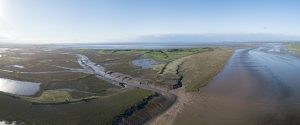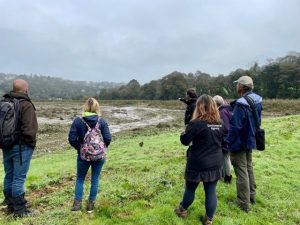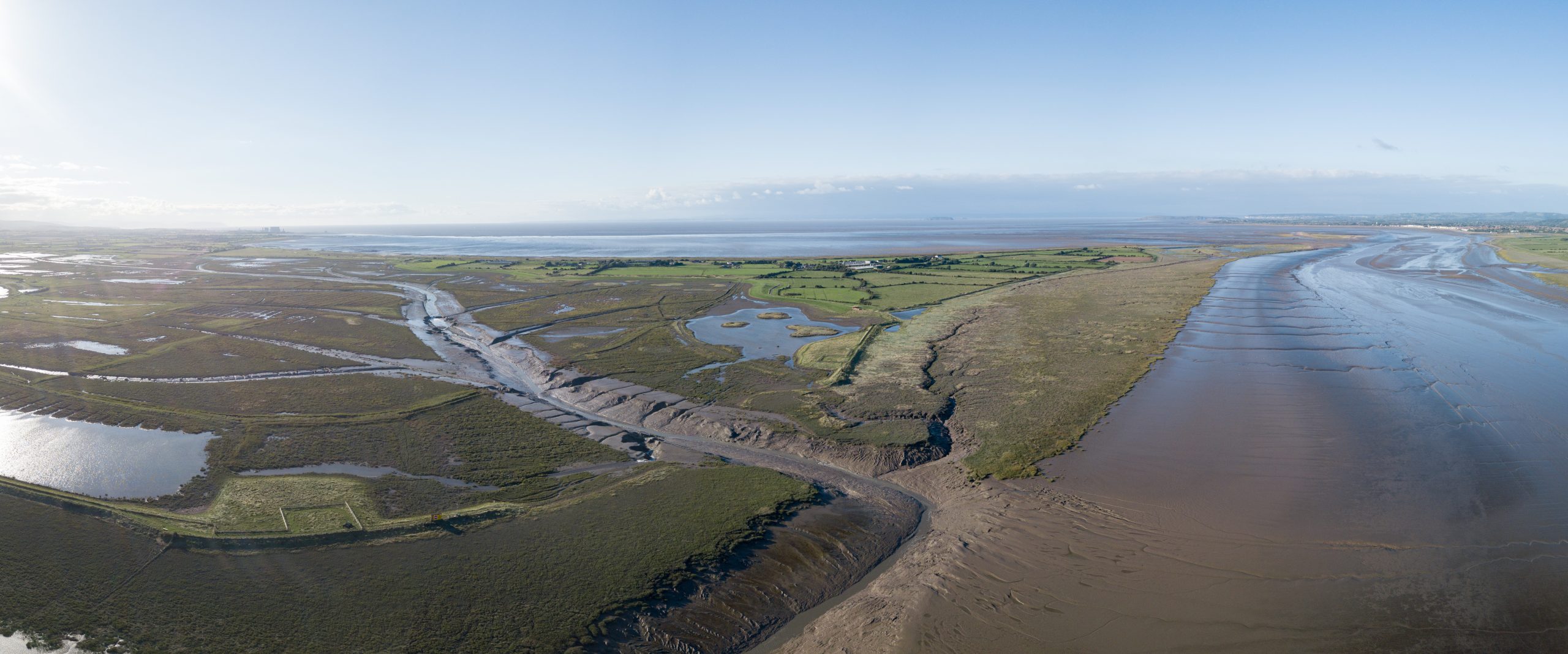Salt marshes may be super, but still need a helping hand – by Eve Leegwater MCIEEM and Dr Ben Green
This blog has been written in conjunction with CIEEM’s upcoming conference ‘Delivering a Nature Positive, Carbon Negative Future.’
Salt marshes, the fringing no-man’s land that meets the sea, often over-looked, muddy, soft-sediments and salty greens – the semicircle of vertical lines peaking in the middle that represent marsh on a map – where ramblers dare to cross.
Up until the mid-20th century, saltmarshes were widely viewed as being of little value to society, inhospitable land waiting to be ‘reclaimed’ for agriculture, human development, or as waste disposal sites. Thankfully, how people view saltmarsh has changed over the past 30 years, albeit gradually and partially thanks to the huge climate change benefits they provide, amongst other benefits. Perhaps they should be renamed ‘super’ salt marshes.

Steart, Sam Stafford from WWT
We now know that saltmarshes are the most widespread and important of the Blue Carbon habitats outside of the tropics. Natural marshes can sequester 2-8 tonnes of CO2-equivalent (CO2e) per hectare per year, but research has shown that there is potential in restored marshes, such as Steart Marshes in Somerset, to sequester significantly more, helping to achieve our Net Zero ambition. They can also reduce high nutrient levels and improve the surrounding water quality, and provide complex, biodiverse habitats for birds and fish.
Restored salt marshes can also be fantastic for people. Coastal communities are some of the most deprived in the country, and habitat restoration could bring in jobs, training, and skills – through site development and related recreation and tourism. For example, a new nature reserve, created in 2002, provided public access to The Wash, attracting more than 50,000 visitors in its second year of opening, who spent an estimated £500,000 locally on food and services[1]. The marshes also provide coastal green spaces to escape and explore, benefiting health and wellbeing that should not be underestimated. We also know that saltmarshes can reduce flood risk – thought to be £1 billion of flood risk benefits in England[2] – through wave attenuation and sediment trapping.
Whilst we have seen a small increase in saltmarsh habitat – approximately 7% in the last decade – it is modest compared to the losses we have seen since the 1800s. We can no longer rely on nature alone to recover and restore these habitats. We need to create the right conditions and put in place the right interventions to assist natural recovery of saltmarsh by removing the pressures – such as excessive nutrients/contaminants and through active intervention – such as realignments and re-charging with sediments.

Eve Leegwater
To date there are a limited but increasing number of restoration and creation projects taking place in estuaries and coasts across England. The first scheme to create saltmarsh habitat was during 1998. Since then, the Environment Agency has completed 72 estuarine and coastal habitat creation schemes to date through managed realignment or regulated tidal exchange, of which 59 have created saltmarsh[3]. Together, the schemes have created approximately 2300 ha of intertidal habitats of which, approximately 1300ha is saltmarsh.
Whilst the Environment Agency has led large-scale habitat creation projects at our coasts such as Medmerry and Steart, these projects are mostly for compensating for coastal squeeze under the Habitat Compensation and Restoration Programme (HCRP). This is the process by which coastal habitats are progressively lost when caught between rising sea level and fixed sea defences. Compensation is needed because many UK coastal habitat areas are protected under national and/or international law and the loss or damage must be compensated in advance, to maintain the ecological integrity of this special network of sites.
The Environment Agency’s HCRP is led by experienced operational staff at a local area level, in close cooperation with Natural England and a range of organisations interested in being part of their delivery. The programme is looking strategically at the likely evolution of wetlands and shorelines, and at the suite of opportunities and benefits to create habitat cost-effectively. During the last 6-year investment programme, the Environment Agency created 471 ha of intertidal habitat. The current HCRP 2021-27 has over 480 hectares of coastal habitat planned for creation.
As well as habitat compensation, the Environment Agency is leading on a cross-Defra initiative called Restoring Meadow, Marsh and Reef (ReMeMaRe) (pronounced “re-memory”), to support the restoration of key estuarine and coastal habitats (saltmarsh, seagrass, native oyster reefs).

Eve Leegwater
ReMeMaRe is supported by a steering group of representatives from Defra arms-length bodies, and a partnership network of environmental non-governmental organisations (eNGOs) pioneering estuarine and coastal restoration across the UK.
The vision of the initiative is for restored estuarine and coastal habitats that benefit people and nature, with a mission to restore at least 15% of our priority habitats along the English coast by 2043 in line with the Defra 25 Year Environment Plan time frame. For saltmarsh, this would be looking to restore approximately 5500 Hectares.
In 2021, ReMeMaRe published a suite of restoration handbooks, including one for saltmarsh with 30 experts across academia, eNGOs, government and industry contributing to it. The initiative is looking to develop a national restoration strategy, identifying priority areas for saltmarsh, seagrass and other habitat restoration, beyond what is currently required for compensation. This includes looking at restoration potential areas together with the potential benefits, and the proximity to areas linked to coastal deprivation.
With the potential of saltmarsh to trap carbon and potentially play a role in carbon offsetting, we at the Environment Agency are keen to support the development of the saltmarsh carbon code to further restoration beyond compensation and support the inclusion of saltmarsh habitats on the UK Greenhouse Gas Inventory.
An agreed, scientifically rigorous saltmarsh carbon code could enable saltmarsh carbon to be marketed and purchased by private investors. This would provide an income stream for restoration projects (including for eNGOs) and supporting the achievement of national net zero goals. We are running a Defra-funded project with external partners this year to identify the broad gaps that exist with regards to blue carbon data in saltmarshes, and how these gaps need to be filled in order to implement a carbon code.
ReMeMaRe partners will be working to promote estuarine and coastal restoration through the implementation of Biodiversity Net Gain, the Landscape Recovery Scheme element of Environment Land Management, and the Local Nature Recovery Strategies, which all provide opportunities for restoration over the next few years.
We recognise that much more investment is needed to ensure our coasts are resilient for the future and are encouraging business and industry to have an increasing role to restore these habitats and protect and enhance the multiple benefits they provide. Government can provide some of that funding to encourage innovation and to give confidence to others to invest but the environment requires a collaborative approach that brings blended investment from all parts of civil society. Let’s give salt marshes the super status and give the habitats, and the species that support them, the helping hand they deserve.
[1] JONES, L. (2011) Coastal margins. In UK National Ecosystem Assessment: Technical Report, Chapter 11, 411-458. Cambridge: UN Environment Programme – World Conservation Monitoring Centre.
[2] Kupper, F.C. and Kamenos, N.A. (2018) Future of Marine Biodiversity and Marine Ecosystem Functioning in UK Coastal and Territorial Waters (including UK Overseas Territories). Foresight Evidence Review.
[3] Environment Agency (2022) The extent and zonation of saltmarsh in England: 2016-2019 An update to the national saltmarsh inventory. Environment Agency external corporate report template (publishing.service.gov.uk)
Blog posts on the CIEEM website are the views and opinions of the author(s) credited. They do not necessarily represent the views or position of CIEEM. The CIEEM blog is intended to be a space in which we publish thought-provoking and discussion-stimulating articles. If you’d like to write a blog sharing your own experiences or views, we’d love to hear from you at SophieLowe@cieem.net.
